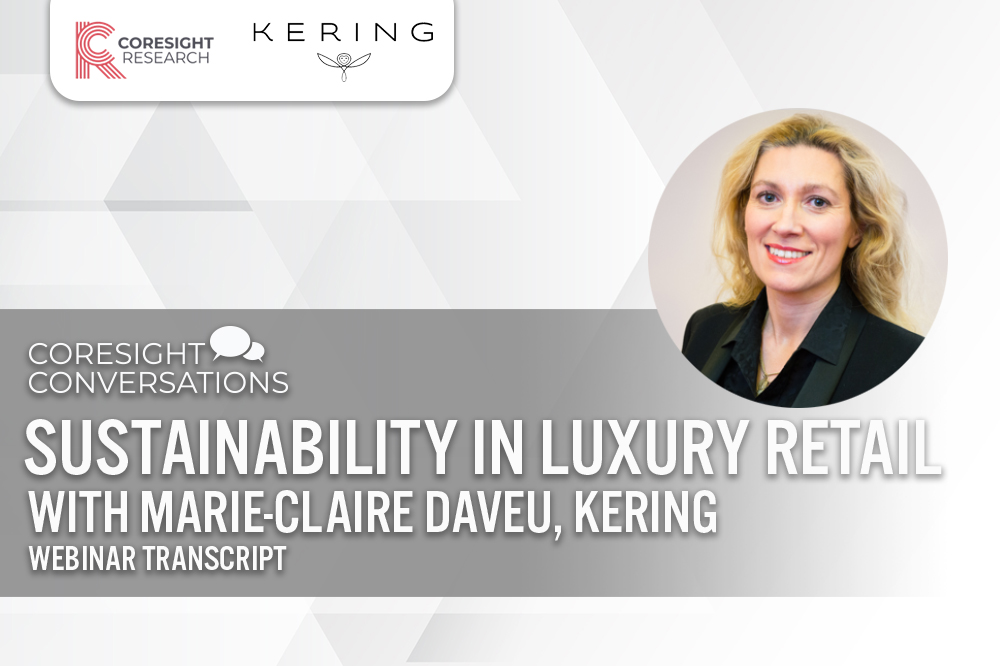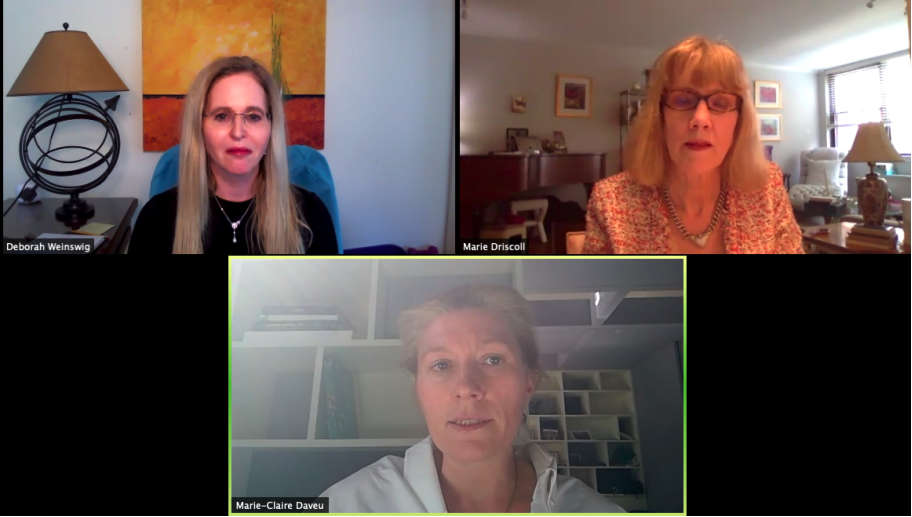
Nitheesh NH
We present an edited version of our conversation with Marie-Claire Daveu, Chief Sustainability Officer of Kering and Head of International Institutional Affairs at Kering, in a webinar held on June 23, 2020. The webinar was co-hosted by Deborah Weinswig, CEO and Founder of Coresight Research, and Marie Driscoll, Managing Director, Luxury and Fashion at Coresight Research.
 Marie-Claire Daveu is Chief Sustainbility Officer and Head of International Institutional Affairs at Kering. She joined Kering in 2012, after previously working as the Director of Sustainable Development for the Sanofi-Aventis Group and at the French Ministries of Ecology, Sustainability, Transport and Housing.
Daveu establishes Kering’s strategy and ambitious sustainability goals, as well as implementing best practices within the international luxury-goods group and the different fashion houses.
Marie-Claire Daveu is Chief Sustainbility Officer and Head of International Institutional Affairs at Kering. She joined Kering in 2012, after previously working as the Director of Sustainable Development for the Sanofi-Aventis Group and at the French Ministries of Ecology, Sustainability, Transport and Housing.
Daveu establishes Kering’s strategy and ambitious sustainability goals, as well as implementing best practices within the international luxury-goods group and the different fashion houses.
 Deborah Weinswig (top left); Marie Driscoll (top right); Marie-Claire Daveu (bottom)
Deborah Weinswig (top left); Marie Driscoll (top right); Marie-Claire Daveu (bottom)
Source: Coresight Research[/caption] I feel that what is really changing a lot is people’s understanding of the potential for huge problems in the future if sustainability and climate change considerations aren’t included in business strategy. I think the mindset is changing and money that is saved can be invested in research, innovation or improving operations. That is why, for me, sustainability is not a curse but an investment.
What are the three most important drivers of sustainability in the end-to-end product customer journey?
I feel that what is really changing a lot is people’s understanding of the potential for huge problems in the future if sustainability and climate change considerations aren’t included in business strategy. I think the mindset is changing and money that is saved can be invested in research, innovation or improving operations. That is why, for me, sustainability is not a curse but an investment.
What are the three most important drivers of sustainability in the end-to-end product customer journey?
 Marie-Claire Daveu is Chief Sustainbility Officer and Head of International Institutional Affairs at Kering. She joined Kering in 2012, after previously working as the Director of Sustainable Development for the Sanofi-Aventis Group and at the French Ministries of Ecology, Sustainability, Transport and Housing.
Daveu establishes Kering’s strategy and ambitious sustainability goals, as well as implementing best practices within the international luxury-goods group and the different fashion houses.
Marie-Claire Daveu is Chief Sustainbility Officer and Head of International Institutional Affairs at Kering. She joined Kering in 2012, after previously working as the Director of Sustainable Development for the Sanofi-Aventis Group and at the French Ministries of Ecology, Sustainability, Transport and Housing.
Daveu establishes Kering’s strategy and ambitious sustainability goals, as well as implementing best practices within the international luxury-goods group and the different fashion houses.
Setting and Meeting Sustainability Goals
How do you define sustainable luxury? For me, sustainability and luxury go hand in hand—when we speak about sustainable luxury it involves paying attention to the best savoir faire, the best heritage and to people and the planet from the raw materials until the end of life of your products. So, it is a huge topic. How do you plan to meet Kering’s “Vision 2025” goal of reducing the company’s ecological imprint by 40%? In 2017, we decided to take a new step in our approach to sustainability, and we defined our strategy plan for 2025, but this was not the starting point of our sustainability journey. Many years ago, Francois Pinault [Founder of Kering] had the idea of putting sustainability at the head of our strategy—he was convinced by the fact that sustainability is good for business and also very important for tax reasons. We decided to have very clear targets and follow a specific schedule to meet our Vision 2025 goals. This includes a 40% in our environmental footprint, but also a 50% reduction in our greenhouse gas emission and goals such as achieving full traceability for our raw materials. Thanks to our dedicated environmental profit and loss account set up several years ago, we are able to measure our environmental footprint every year and publish the results for transparency purposes. In terms of categories, we didn’t start on specific materials such as leather or cashmere, but rather worked on all raw materials across a brand as a whole. For example, for Gucci to reduce its environmental impact by 40%, the brand will work on leather, while Boucheron will work on gold. It is really dependent on the brands, which is why we have defined an action plan for each brand to ensure that we will be able to reach our targets. During Covid, many businesses and customers pushed sustainability to the side as it seemingly became less of a priority—what did you notice and how did Kering react? From an operational perspective, I think it encouraged us to accelerate implementation of our targets and to try to reach them as fast as possible. We still aim to hit our 2025 target and obtain the goals we put in place in 2017. We have increased awareness about sustainability, biodiversity and climate change but it is a long journey. Change does not happen overnight, but I think the Covid-19 crisis has led people to reflect on the link between humans and nature and what climate change means for them. I have the feeling that, going forward, people will be asking more and more questions and will start and continue to expect brands to take responsibility and proper action—and not only for the textile industry but across the board. [caption id="attachment_115680" align="aligncenter" width="700"] Deborah Weinswig (top left); Marie Driscoll (top right); Marie-Claire Daveu (bottom)
Deborah Weinswig (top left); Marie Driscoll (top right); Marie-Claire Daveu (bottom)Source: Coresight Research[/caption]
Being Profitable with Sustainability
The common notion is often that sustainability and profitability do not overlap, but recently, we have seen a significant increase in brands finding sustainability solutions that can actually drive profitability—for both the top and bottom line. What are you seeing in regard to this mutual benefit? I always have the same answer to this because as you mentioned, when we speak about sustainability, it is usually the costs that draw criticism and are given as the reason for holding people back. At Kering, we have always been convinced that sustainability is an investment. At the same time, it could help us to reduce costs in some areas—take energy as an example, or water,—if you reduce your consumption of energy or water you can ultimately save money. Of course, you have to accept the fact that sometimes for some projects, such as investing in renewable energy, the payback may take five or ten years. However, at the end of the day, there will be things that can bring you huge benefits. I feel that what is really changing a lot is people’s understanding of the potential for huge problems in the future if sustainability and climate change considerations aren’t included in business strategy. I think the mindset is changing and money that is saved can be invested in research, innovation or improving operations. That is why, for me, sustainability is not a curse but an investment.
What are the three most important drivers of sustainability in the end-to-end product customer journey?
I feel that what is really changing a lot is people’s understanding of the potential for huge problems in the future if sustainability and climate change considerations aren’t included in business strategy. I think the mindset is changing and money that is saved can be invested in research, innovation or improving operations. That is why, for me, sustainability is not a curse but an investment.
What are the three most important drivers of sustainability in the end-to-end product customer journey?
- Perhaps the most important thing is traceability—really knowing where raw materials come from.
- We also see customers asking questions about product life cycles after first use, so we are considering how to restart the product cycle or upcycle our products.
- Lastly, it is important to have these discussions in the boutique, because it is a way to stimulate conversation within and with other brands.